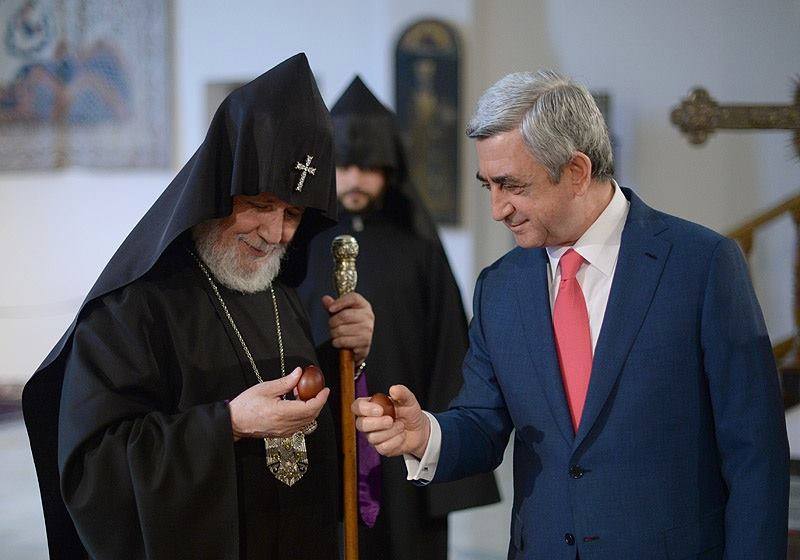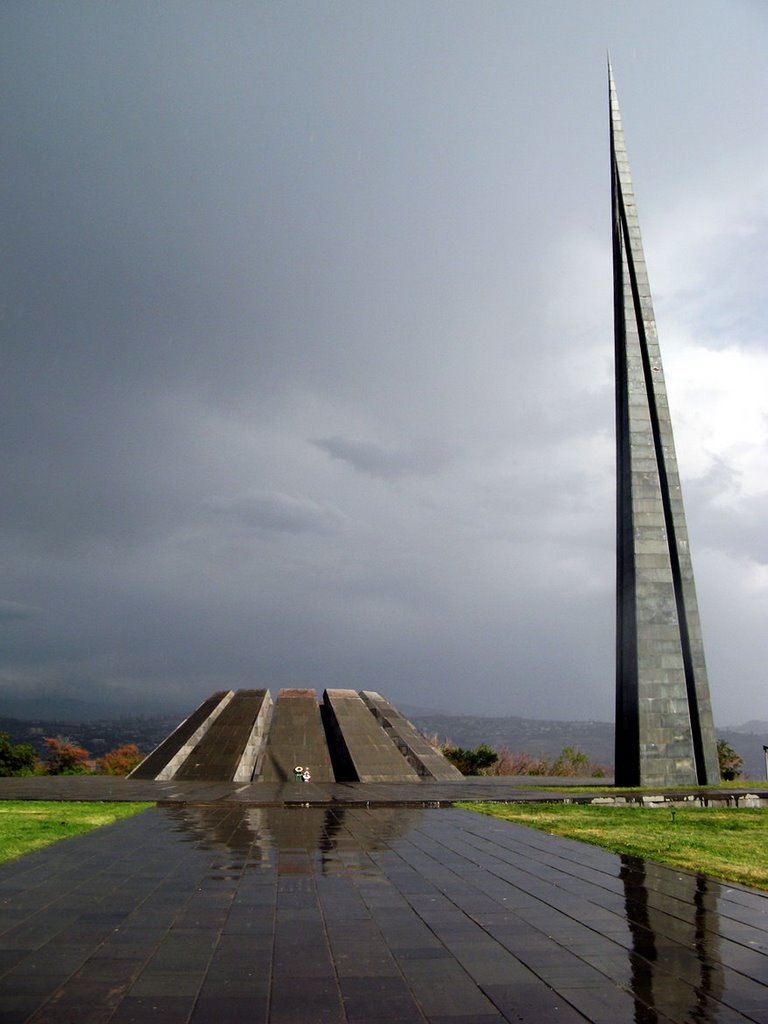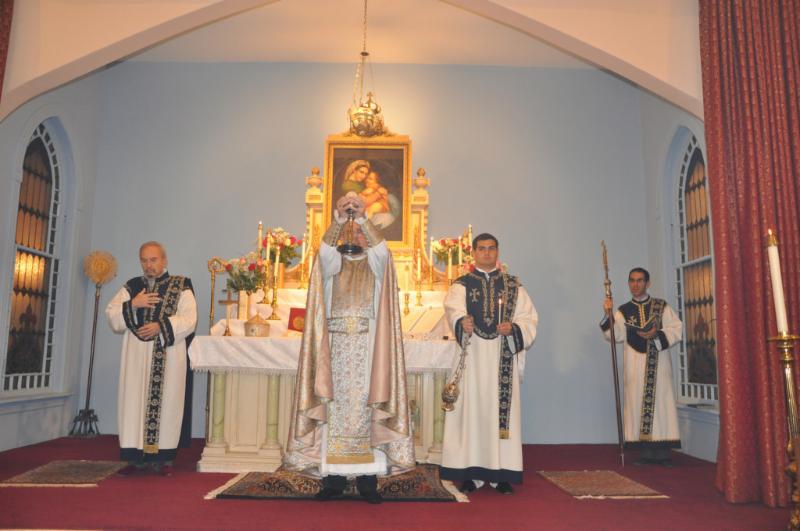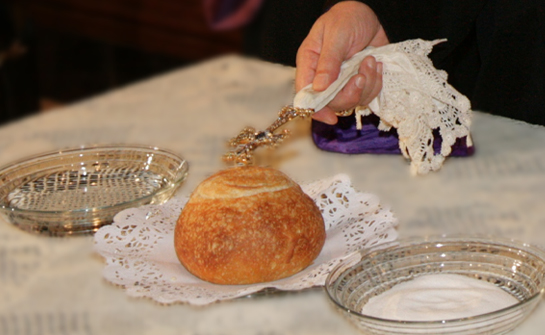SUNDAY, April 27, 2014
Octave of Easter-New Sunday
Morning Service: 9:15 AM
Divine Liturgy: 10:00 AM
Bible Readings: Acts 5:31-6:7; James 3:1-12; John 1:1-17
HOKEHANKISD- REQUIEM SERVICE
For the souls of The Martyrs of the Armenian Genocide in 1915.
SPECIAL MERELOTZ REQUIEM SERVICE
For the souls of Mardiros Tatosian, Zumrut Tatosian, Oscar Isberian, Lucinetak Isberian, Heranush Salvakoglu, John Louden.
Requsted by Tatosian family
For the souls of Levon Galstyan and the deceased members of Khoja-Eynatyan, Simonyan, Ayvazyan, Arakelian families.
Requested by Der Hovhan.
If you wish to add names to Sunday's Merelotz Special Requiem Service please submit them to one of our deacons before Der Voghormya.
|
|
Octave of Easter - New Sunday
 The Sunday which follows Easter Sunday is called New Sunday because it is the first Sunday after the Resurrection [Easter]. Aside from the Resurrection of Christ, this day also reflects calling of and conversion of the pagans to Christianity; and, the growth and expansion of Christ's Church. Hence, it falls into Church's listing of holy days. ANALOGICALLY, New Sunday or Nor Giragi also reflects the new relationship of God's People. The Christian Church had replaced the tribe of Judah as the new "Israel". Israel means "people of the covenant". The word Israel is not a geographical location, but rather the name or reference to a people in a special covenant or relationship with God. With their denial of Christ the Israel of the Old Testament [old covenant] relinquished their role as the "Israel" of God's covenant. The "new" sons of Zion [Arm. Sioni Vortik], being the Body of Christ [the Church = Arm. Ecceghetsi = Grk. Ecclesia] is in fact the "new" Israel. Therefore, in its role of Israel, the people of the covenant [Christian Church] are the heirs to or recipients of the promise of salvation through Christ's death and resurrection. By virtue of its being the eighth day of Easter [octave] and a day similar to Easter it has been called Grgnazadig [Easter Repeated]. The Church has wisely chosen the Gospel of John's prologue as its reading for "New Sunday" because it powerfully proclaims Jesus as the Son of God, the Word made flesh. Although Jesus took upon Himself full humanity and lived as a man, he never ceased to be the eternal God who has always existed, the Creator and Sustainer of all things, and the source of eternal life. This is the foundation of all truth.
(From Domar: the calendrical and liturgical cycle of the
Armenian Apostolic Orthodox Church, 2003 A.D.
Published by Armenian Orthodox Theological Research Institute.)
|
|
|
Memorial Services (Hokehankisd) in the Armenian Church

We believe that the faithful who are deceased are still the Lord's: If we live to the Lord, and if we die, we die to the Lord; so then, whether we live or whether we die, we are the Lord's. For to this end Christ died and lived again, that he might be Lord both of the dead and the living (Rom 14: 8-9). The faithful who are dead are merely asleep in Christ. This concept, which is in St. Paul's epistles (1 Cor 15; 1 Thes 4 and 5) is one of the basic teachings of the Armenian Church, and the term 'asleep' in its past participial form [nunchetsyal] is used formally in reference to a deceased person. Like the faithful who are alive, the faithful who are deceased are a part of the corporate body of Christ and therefore of the Church. Those who are asleep in Christ and have reached the end of their earthly lives in the faith are referred to as the 'first born' or the Victorious Church.
What are the different requiem services in the Armenian Church?
In the Armenian tradition there are different rituals after the funeral services and the internment of a Christian. These are held at various intervals. For convenience we shall refer to them as requiem services. The Book of Rituals [Mashdots] has special services for:
In the past, all the requiem services required the preparation of food and its distribution to the poor. This was the Armenian Christian way of providing for the deprived. This tradition has evolved today and is partially observed in the form of the hokejash. The blessing of Madagh is in most cases a requiem service, and the blessed food or meat is distributed to the poor and the public at large in memory of the deceased person/persons, whose name is/are mentioned in the prayer read by the clergyman. Blessed these, it must be noted that prayers for the deceased are said during the liturgical hours and the Divine Liturgy, and a short requiem service is required during the Night Hour, if the Divine Liturgy will be celebrated on that day.
These services, practices and traditions give us an opportunity to pray for our deceased dear ones and the receive consolation through the grace of the Holy Spirit.
What is the proper mourning period for a deceased?
Before examining the duration of the mourning period and the services following the internment, another question frequently raised by parishioners must be answered. Does one start calculating the time of mourning from the day when the deceased has died or from the day of his internment? This was never an issue in the old days, since the deceased was buried on the day he died. If the death occurred later in the day, the burial took place on the following day. Today, in countries where there is a wake prior to the burial, time should be calculated from the day of the burial services and the internment.
The forty-day mourning period
The forty days of mourning [karasoonk], says St. Gregory of Datev, has as precedent the wailing over Jacob/Israel. But his comment and our tradition are based neither on the Hebrew Scriptures nor on the present reading of the Septuagint, but on the ancient Armenian version of the Bible, which reads: and the embalmers embalmed [literally, covered] Israel. And his forty days were fulfilled; for so were the days numbered of those who were buried.
We see in the Old Testament, and know from various Armenian writers that besides wailing for the dead and other similar expressions of grief, the bereaved abstained from eating rich food, drinking and even bathing. The association of mourning with fasting and the example of Jacob presumably led to the present practice of observing a forty-day mourning period we observe today. The practice was probably further developed under the influence of the forty-day Lenten period, during which the Church requires absolute abstinence from rich foods. The fortieth day of the internment marks the end of mourning, when the bereaved make a request for and participate in the celebration of the Divine Liturgy, then go to the graveside for a requiem service. Today the requiem service is held in the church, with a shorter service at the graveside.
First anniversary requiem
The significance of the first anniversary [dareleets] of the internment, and the annual observance of the burial is not clear, but the Book or Rituals does mention the dareleets and the tradition has been retained. At the first anniversary the family of the deceased makes a request for and participates in the celebration of the Divine Liturgy, and proceeds to the graveside for a requiem service. Today the requiem service is held in the church, with a shorter service at the graveside.
| |
(From "Frequently Asked Questions about the Armenian Church"
by Very Rev. Fr. Krikor Maksoudian)
|
|
Photo of the Week
 | |
Havgtakhagh
|
|
|
Altar Guild's Wish List
1. Two jajanch radiances (ostensorium). $300-600 each . Pledged.
2. Painting of St. James of Nisibis. $1000. Not pledged.
3. Painting of St. Stephen the Protodeacon. $1000. Not pledged.
4. Priest's 'half-vestments'. $500. Not pledged.
5. Censer stand- $400, not pledged
Sunday School's Wish List
1. Cabinet for storage of books and supplies. Not pledged.
2. Room furniture for students and teachers. Not pledged.
|
|
|
IN COMMEMORATION OF MARTYRS OF THE ARMENIAN GENOCIDE AND
IN CELEBRATION OF THE SPIRIT OF SURVIVAL AND VICTORY WITH THE RESURRECTION OF OUR LORD
THE ACYOA OF ST. JAMES
proudly presents
YOUNG TALENTS
Commemorative Concert
and
Screening of 28 minute documentary
"WHERE ARE MY PEOPLE"
by Michael Hagopian

SUNDAY, APRIL 27, 2014
at 12:30 PM
at St. James Armenian Church
|
|
INSTRUCTIONAL DIVINE LITURGY
IN ARMENIAN
May 4, 2014

During the celebration of the Divine Liturgy we will stop to offer explanations of what is going on. This program is ideal for those who shy away from the Soorp Badarak because of lack of understanding.
To receive the full teaching it's essential that you are present from the beginning at 10:00 AM, when we explain the vestments worn by the celebrant priest.
|
|
10th ANNIVERSARY OF PASSING OF
VERY REVEREND FATHER VAROUJAN KABARAJIAN
(1928 - 2004)
Saturday, May 10, 2014
4:15 PM - Prayer at the graveside
5:00 PM - Vespers and Memorial Service (Hokehankisd) at St. James
Followed by Memorial Dinner in the Nishan Hall.
RSVP by May 4, 2014
by calling (847) 864-6263 or by e-mail [email protected]
Click here for more details.
|
|
ARMENIAN DANCE COMPANY OF CHICAGO JUNIORS
Present
"NOR SEROUNT"
"NEW GENERATION"
Saturday, May 3 at 6:00PM
performance followed by dinner
$20 adults and children (dinner included)
For tickets call Annie Kerkonian: 847.830.3881
AGBU Center 7248 N. Harlem Ave. Chicago
|
EASTER HOME BLESSING

Easter season is the time when homes are blessed by the Pastor. All parishioners who wish to have their homes blessed on the occasion of Easter should call Der Hovhan (847) 644-7389 to make arrangements.
Have a piece of bread, dish of salt and glass of water available for the blessing.
|
|
YOUTH ISSUE OF E-BULLETIN
Click here to access our special E-Bulletin featuring numerous programs (camps, retreats, training, scholarships, etc) made available to you by our parish, the Diocese, St. Nersess Armenian Seminary, AGBU, Armenian Assembly of America and the RA Ministry of Diaspora.
|
|
E-BULLETIN ARCHIVE IS NOW AVAILABLE
Missed or accidentally deleted any of the previous E-Bulletins?
You can read all our previous issues in the archive here.
|
PLEASE SIGN UP FOR A COFFEE HOUR
Coffee hour tables can be simple or complex. Sometimes when people do a coffee hour table they put out coffee cakes and doughnuts; sometimes they put out some fruits. Others put out entire lunch. We encourage you to sign up for coffee hour a couple of times each year. It can be simple or an entire meal - either is fine. The sign-up sheet is in the church hall.
|
|